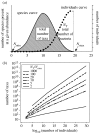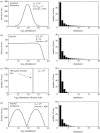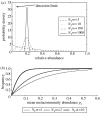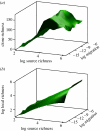What is the extent of prokaryotic diversity?
- PMID: 17028084
- PMCID: PMC1764926
- DOI: 10.1098/rstb.2006.1921
What is the extent of prokaryotic diversity?
Abstract
The extent of microbial diversity is an intrinsically fascinating subject of profound practical importance. The term 'diversity' may allude to the number of taxa or species richness as well as their relative abundance. There is uncertainty about both, primarily because sample sizes are too small. Non-parametric diversity estimators make gross underestimates if used with small sample sizes on unevenly distributed communities. One can make richness estimates over many scales using small samples by assuming a species/taxa-abundance distribution. However, no one knows what the underlying taxa-abundance distributions are for bacterial communities. Latterly, diversity has been estimated by fitting data from gene clone libraries and extrapolating from this to taxa-abundance curves to estimate richness. However, since sample sizes are small, we cannot be sure that such samples are representative of the community from which they were drawn. It is however possible to formulate, and calibrate, models that predict the diversity of local communities and of samples drawn from that local community. The calibration of such models suggests that migration rates are small and decrease as the community gets larger. The preliminary predictions of the model are qualitatively consistent with the patterns seen in clone libraries in 'real life'. The validation of this model is also confounded by small sample sizes. However, if such models were properly validated, they could form invaluable tools for the prediction of microbial diversity and a basis for the systematic exploration of microbial diversity on the planet.
Figures











Similar articles
-
Bacterial diversity in aquatic and other environments: what 16S rDNA libraries can tell us.FEMS Microbiol Ecol. 2004 Feb 1;47(2):161-77. doi: 10.1016/S0168-6496(03)00257-5. FEMS Microbiol Ecol. 2004. PMID: 19712332
-
Prokaryotic genetic diversity throughout the salinity gradient of a coastal solar saltern.Environ Microbiol. 2002 Jun;4(6):349-60. doi: 10.1046/j.1462-2920.2002.00306.x. Environ Microbiol. 2002. PMID: 12071980
-
Species richness in soil bacterial communities: a proposed approach to overcome sample size bias.J Microbiol Methods. 2008 Sep;75(1):86-91. doi: 10.1016/j.mimet.2008.05.009. Epub 2008 May 15. J Microbiol Methods. 2008. PMID: 18585806
-
The tragedy of the uncommon: understanding limitations in the analysis of microbial diversity.ISME J. 2008 Jul;2(7):689-95. doi: 10.1038/ismej.2008.44. Epub 2008 May 8. ISME J. 2008. PMID: 18463690 Review.
-
The generation and maintenance of diversity in microbial communities.Am J Bot. 2011 Mar;98(3):439-48. doi: 10.3732/ajb.1000498. Epub 2011 Feb 17. Am J Bot. 2011. PMID: 21613137 Review.
Cited by
-
Biophysical controls on community succession in stream biofilms.Appl Environ Microbiol. 2007 Aug;73(15):4966-74. doi: 10.1128/AEM.00588-07. Epub 2007 Jun 8. Appl Environ Microbiol. 2007. PMID: 17557861 Free PMC article.
-
Towards a conceptual and operational union of bacterial systematics, ecology, and evolution.Philos Trans R Soc Lond B Biol Sci. 2006 Nov 29;361(1475):1985-96. doi: 10.1098/rstb.2006.1918. Philos Trans R Soc Lond B Biol Sci. 2006. PMID: 17062416 Free PMC article.
-
From structure to function: the ecology of host-associated microbial communities.Microbiol Mol Biol Rev. 2010 Sep;74(3):453-76. doi: 10.1128/MMBR.00014-10. Microbiol Mol Biol Rev. 2010. PMID: 20805407 Free PMC article. Review.
-
Ubiquity of Polynucleobacter necessarius subspecies asymbioticus results from ecological diversification.Environ Microbiol. 2011 Apr;13(4):922-31. doi: 10.1111/j.1462-2920.2010.02396.x. Epub 2011 Jan 5. Environ Microbiol. 2011. PMID: 21208356 Free PMC article.
-
Virio- and bacterioplankton microscale distributions at the sediment-water interface.PLoS One. 2014 Jul 24;9(7):e102805. doi: 10.1371/journal.pone.0102805. eCollection 2014. PLoS One. 2014. PMID: 25057797 Free PMC article.
References
-
- Bell G. The distribution of abundance in neutral communities. Am. Nat. 2000;155:606–617. doi:10.1086/303345 - DOI - PubMed
-
- Bell G. Ecology—neutral macroecology. Science. 2001;293:2413–2418. doi:10.1126/science.293.5539.2413 - DOI - PubMed
-
- Brock T. Prentice-Hall; Englewood Cliffs, NJ: 1966. Principles of microbial ecology.
-
- Brown J.H. University of Chicago Press; Chicago, IL: 2000. Macroecology.
MeSH terms
LinkOut - more resources
Full Text Sources

